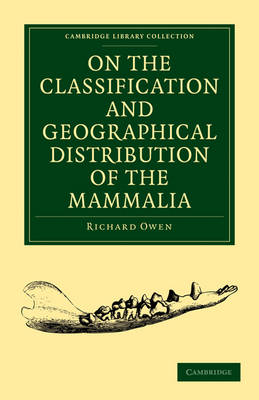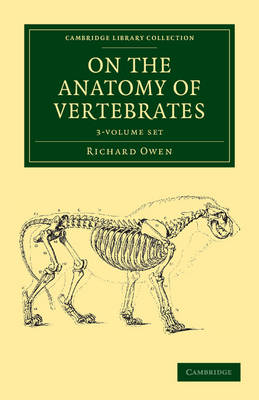Cambridge Library Collection - Zoology
3 primary works • 6 total works
Volume 1
On the Anatomy of Vertebrates: Volume 1, Fishes and Reptiles
by Richard Owen
Published 29 December 2011
Richard Owen F.R.S. (1804–92) was a controversial and influential palaeontologist and anatomist. Owen studied medicine at the University of Edinburgh and at London's St Bartholomew's Hospital. He grew interested in anatomical research, and after qualifying he became assistant conservator in the museum of the Royal College of Surgeons, and then superintendent of natural history in the British Museum. He quickly became an authority on comparative anatomy and palaeontology, coining the term 'dinosaur' and founding the Natural History Museum. He was also a fierce critic of Darwin's theory of evolution by natural selection, and engaged in a long and bitter argument with Darwin's 'Bulldog', Thomas Huxley. Published in 1866, this is the first book in a highly illustrated three-volume set that comprises a thorough overview of vertebrate anatomy. This volume focuses on the anatomy of fishes and reptiles, and includes a preface that outlines the author's views on anatomical methodology.
Volume 2
On the Anatomy of Vertebrates: Volume 2, Birds and Mammals
by Richard Owen
Published 29 December 2011
Richard Owen F.R.S. (1804–92) was a controversial and influential palaeontologist and anatomist. Owen studied medicine at the University of Edinburgh and at London's St Bartholomew's Hospital. He grew interested in anatomical research, and after qualifying he became assistant conservator in the museum of the Royal College of Surgeons, and then superintendent of natural history in the British Museum. He quickly became an authority on comparative anatomy and palaeontology, coining the term 'dinosaur' and founding the Natural History Museum. He was also a fierce critic of Darwin's theory of evolution by natural selection, and engaged in a long and bitter argument with Darwin's 'Bulldog', Thomas Huxley. Published in 1866, this is the second book in a highly illustrated three-volume set that comprises a thorough overview of vertebrate anatomy. This volume focuses on the anatomy of birds, and includes the first part of the analysis of mammalian anatomy.
Volume 3
Richard Owen F.R.S. (1804–92) was a controversial and influential palaeontologist and anatomist. Owen studied medicine at the University of Edinburgh and at London's St Bartholomew's Hospital. He grew interested in anatomical research, and after qualifying he became assistant conservator in the museum of the Royal College of Surgeons, and then superintendent of natural history in the British Museum. He quickly became an authority on comparative anatomy and palaeontology, coining the term 'dinosaur' and founding the Natural History Museum. He was also a fierce critic of Darwin's theory of evolution by natural selection, and engaged in a long and bitter argument with Darwin's 'Bulldog', Thomas Huxley. Published in 1868, this is the third book in a highly illustrated three-volume set that comprises a thorough overview of vertebrate anatomy. This volume completes the analysis of mammalian anatomy and includes a chapter of general conclusions.
On the Classification and Geographical Distribution of the Mammalia
by Richard Owen
Published 20 July 2009
English anatomist and biologist Richard Owen (1804–92), who in 1842 coined the word 'dinosaur', published this book in 1859, the year of On the Origin of Species. He reviews ancient and recent studies of mammals in Western science before going on to present his own updated categorisation of the class. Owen's eye for detail and range of scholarship are evident in this work, which is an extensive catalogue of mammals based on biological, geographical and anatomical characteristics. It incorporates, among other things, detailed classifications and sub-classifications of genus based on dental structures, food habits and cerebra. Owen's prose is lucid and precise and his investigations scrupulous, demonstrating the commitment that led him to become one of the foremost anatomists of his time. An appendix reveals Owen's views on the hotly debated theories of transmutation and extinction proposed by scientists such as Lamarck, Lyell and Darwin.
On the Extent and Aims of a National Museum of Natural History
by Richard Owen
Published 3 November 2011
A significant limitation on the development of zoology, botany and palaeontology in the mid-nineteenth century was the absence of a centralised collection of specimens. Appointed superintendent of the British Museum's natural history departments in 1859, the distinguished biologist Richard Owen (1804–92) quickly realised the need to make various scattered samples more readily available for study, and began campaigning for a new, national museum with unprecedented space and resources. This book is the text of one of his speeches to the Royal Institution, given in 1861 and first published in 1862. He argues against the usual practice of exhibiting only one type form for each genus, provides possible floor plans, and presents case studies across the zoological field which show the limitations of the then current system. He also stresses a new idea, that such a museum should aim not only to help scientists, but to educate the general public.
Richard Owen F.R.S. (1804-92) was a controversial and influential palaeontologist and anatomist. Owen studied medicine at the University of Edinburgh and at London's St Bartholomew's Hospital. He grew interested in anatomical research, and after qualifying he became assistant conservator in the museum of the Royal College of Surgeons, and then superintendent of natural history in the British Museum. He quickly became an authority on comparative anatomy and palaeontology, coining the term 'dinosaur' and founding the Natural History Museum. He was also a fierce critic of Darwin's theory of evolution by natural selection, and engaged in a long and bitter argument with Darwin's 'Bulldog', Thomas Huxley. Published between 1866 and 1868, this highly illustrated three-volume set comprises a thorough overview of vertebrate anatomy. Volume 1 deals with cold-blooded vertebrates such as fish and reptiles, Volume 2 birds, and Volume 3 mammals.


